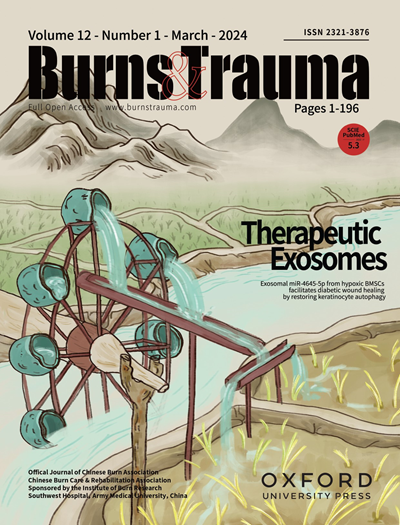积雪草苷-一氧化氮通过调节关键代谢物和SRC/STAT3信号传导协同加速糖尿病伤口愈合
IF 9.6
1区 医学
Q1 DERMATOLOGY
引用次数: 0
摘要
糖尿病伤口由于愈合过程受损,常常导致慢性、不愈合的溃疡,给临床带来了重大挑战。积雪草苷(Asiaticoside, AC)是一种从积雪草中提取的天然三萜衍生物,具有显著的抗炎和伤口愈合作用。然而,一氧化氮(NO) -公认的伤口愈合促进剂-与AC联合治疗糖尿病伤口的协同作用仍未充分探讨。方法采用超高效液相色谱-串联质谱(UPLC-MS/MS)鉴别与糖尿病创面相关的差异代谢物和代谢异常途径。分子对接分析证实了AC与关键治疗靶点的结合亲和力。采用RT-qPCR和western blotting检测积雪草苷-一氧化氮水凝胶(ACNO)对基因和蛋白表达的影响。采用SRC激动剂和抑制剂进行体外实验,研究ACNO治疗对HaCaT细胞中SRC、STAT3和其他蛋白表达的影响。结果代谢组学分析显示,小鼠糖尿病伤口表现出明显的代谢失调,ACNO治疗可减轻这种失调。ACNO调节的主要代谢物包括扁桃酸、乳酸和3-羟基异戊酸。主要代谢途径是甲基组氨酸代谢和苹果酸-天冬氨酸穿梭。免疫荧光染色证实ACNO治疗增强血管生成,促进细胞增殖,促进糖尿病伤口愈合。RT-qPCR数据显示,ACNO调节关键基因(SRC、STAT3、EGFR和VEGFA)的转录。值得注意的是,ACNO减弱了SRC/STAT3通路的激活,同时上调了EGFR和VEGFA的表达。这些发现强调了ACNO水凝胶通过调节代谢途径和SRC/STAT3信号轴在糖尿病伤口愈合中的治疗潜力。通过将改变的代谢物与分子靶点相关联,本研究阐明了ACNO临床前应用的药效学基础,并为糖尿病伤口治疗的靶向治疗提供了有价值的见解。本文章由计算机程序翻译,如有差异,请以英文原文为准。
Asiaticoside-nitric oxide synergistically accelerate diabetic wound healing by regulating key metabolites and SRC/STAT3 signaling
Background Diabetic wounds pose significant clinical challenges due to impaired healing processes, often resulting in chronic, non-healing ulcers. Asiaticoside (AC), a natural triterpene derivative from Centella asiatica, has demonstrated notable anti-inflammatory and wound-healing properties. However, the synergistic effects of nitric oxide (NO)—a recognized promoter of wound healing—combined with AC in treating diabetic wounds remain inadequately explored. Methods Ultra-performance liquid chromatography–tandem mass spectrometry (UPLC-MS/MS) was utilized to identify differential metabolites and dysregulated metabolic pathways associated with diabetic wounds. Molecular docking analyses were conducted to confirm the binding affinity of AC to key therapeutic targets. The effects of Asiaticoside-nitric oxide hydrogel (ACNO) on gene and protein expression were evaluated using RT-qPCR and western blotting. In vitro experiments using SRC agonists and inhibitors were performed to investigate the impact of ACNO therapy on the expression of SRC, STAT3, and other proteins in HaCaT cells. Results Metabolomic profiling revealed that diabetic wounds in mice exhibited marked metabolic dysregulation, which was attenuated by ACNO treatment. Key metabolites modulated by ACNO included mandelic acid, lactic acid, and 3-hydroxyisovaleric acid. The primary metabolic pathways involved were methyl histidine metabolism and the malate–aspartate shuttle. Immunofluorescence staining confirmed that ACNO therapy enhanced angiogenesis, promoted cellular proliferation, and facilitated diabetic wound closure. RT–qPCR data demonstrated that ACNO regulated the transcription of critical genes (SRC, STAT3, EGFR, and VEGFA). Notably, ACNO attenuated SRC/STAT3 pathway activation while concurrently upregulating EGFR and VEGFA expression. Conclusions These findings emphasize the therapeutic potential of ACNO hydrogel in diabetic wound healing through the modulation of metabolic pathways and the SRC/STAT3 signaling axis. By correlating altered metabolites with molecular targets, this study elucidates the pharmacodynamic foundation for ACNO’s pre-clinical application and provides valuable insights into the development of targeted therapies for diabetic wound management.
求助全文
通过发布文献求助,成功后即可免费获取论文全文。
去求助
来源期刊

Burns & Trauma
医学-皮肤病学
CiteScore
8.40
自引率
9.40%
发文量
186
审稿时长
6 weeks
期刊介绍:
The first open access journal in the field of burns and trauma injury in the Asia-Pacific region, Burns & Trauma publishes the latest developments in basic, clinical and translational research in the field. With a special focus on prevention, clinical treatment and basic research, the journal welcomes submissions in various aspects of biomaterials, tissue engineering, stem cells, critical care, immunobiology, skin transplantation, and the prevention and regeneration of burns and trauma injuries. With an expert Editorial Board and a team of dedicated scientific editors, the journal enjoys a large readership and is supported by Southwest Hospital, which covers authors'' article processing charges.
 求助内容:
求助内容: 应助结果提醒方式:
应助结果提醒方式:


